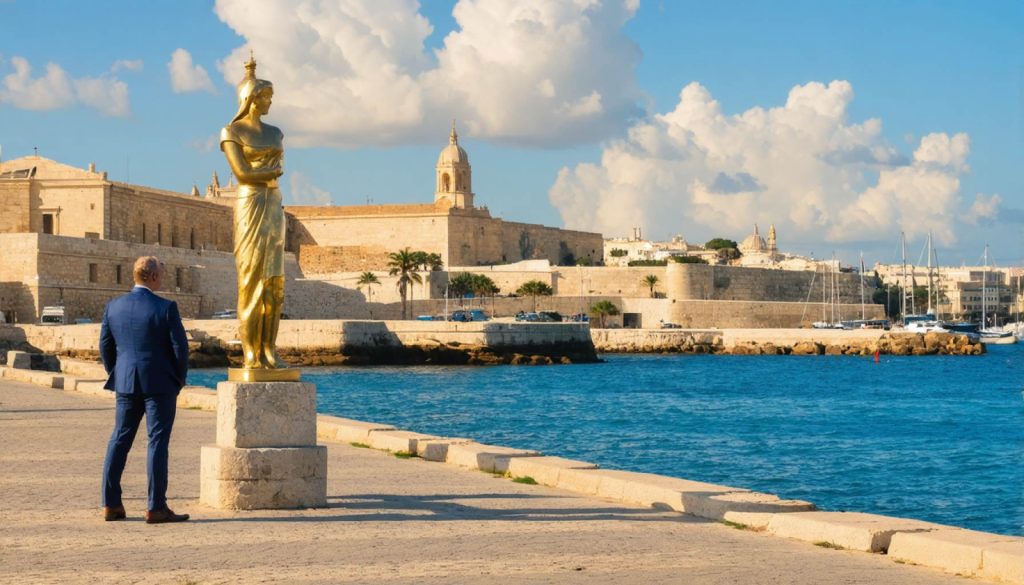
- Maltese public debt has grown significantly, reaching over three times its size from two decades ago, posing economic challenges.
- Malta’s economy remains vibrant, with Valletta attracting businesses and investments, particularly in the thriving tech sector.
- Public debt fuels essential infrastructure and social programs but demands careful management to prevent future economic instability.
- Leadership must balance immediate economic needs with sustainable long-term fiscal strategies to ensure continued prosperity.
- The pressure of public debt, though unseen by tourists, plays a critical role in shaping Malta’s economic future.
Maltese shores have long been bathed in the cerulean embrace of the Mediterranean, luring travelers with sunlit promises and ancient stories. Beneath this picturesque veneer, however, lies a pressing narrative that requires our gaze: Malta’s public debt, an invisible anchor with the potential to drag its economy into uncertain waters.
Recent years have seen Malta grappling with financial obligations that seem to rise like the relentless tides. As of late 2023, the island nation’s public debt hovers beyond three times the size it was just two decades ago, painting a vivid picture of growth shadowed by financial strain. Influenced by global market fluctuations and domestic economic demands, this debt cannot be ignored.
Despite this looming challenge, Malta has continued to thrive economically. The bustling streets of Valletta hum with the energy of progress, inviting new businesses and investments. Malta’s tech sector, a shining beacon amidst its economic landscape, has attracted significant attention, promising innovation and prosperity. Yet, with growth comes responsibility, and managing this balance requires more than mere numbers on a spreadsheet.
The island’s debt story intertwines with its rich tapestry of achievements. Key to understanding how public financial commitments affect island life is recognizing that these debts, while daunting, fuel critical infrastructure and social programs. Roads are paved, schools are built, and health systems are improved—all under the weight of these financial burdens.
Yet, with each investment and promise of a better tomorrow, Malta edges toward a precipice. Careful navigating is imperative—leadership must masterfully balance immediate needs with long-term viability. Otherwise, the tidal forces of unchecked debt could undermine Malta’s shimmering facade of growth.
Takeaway: As Malta continues its quest for a sustainable economic model, a keen understanding and management of its public debt are vital. Responsible fiscal strategies are needed to ensure that current growth does not mortgage the future. The hidden pressure of public debt may not be visible to the sun-seekers on Malta’s beaches, but it is a force that undeniably shapes the island’s horizon.
Unveiling Malta’s Economic Struggles: The Hidden Impact of Public Debt
Understanding Malta’s Economic Landscape
Malta, a Mediterranean jewel, portrays a thriving economy underpinned by tourism, finance, and an emerging tech sector. Despite this progress, Malta’s public debt remains a crucial challenge, growing more than threefold over the past two decades. This debt is intricately linked to both global market influences and domestic economic pressures.
The Role of Debt in Economic Growth
Public debt in Malta is not merely a financial burden. It fuels significant capital expenditures that have yielded crucial infrastructure developments. Investments in roads, schools, and healthcare improvements are directly supported by this debt, paving the way for enhanced quality of life and economic development.
Pros:
– Facilitates infrastructure development.
– Supports public services and social programs.
Cons:
– Potential to lead to financial instability if not managed correctly.
– Could hinder long-term economic growth if misaligned with fiscal strategies.
Market Forecasts & Industry Trends
The tech industry in Malta has been a significant catalyst for economic growth, attracting global investment. Initiatives in blockchain technology and digital finance highlight Malta’s forward-thinking approach. According to World Bank data, if Malta effectively leverages its tech sector, it could offset some debt-related concerns by generating substantial revenue and employment.
Challenges and Limitations
Despite economic opportunities, Malta faces challenges such as its limited size, reliance on external market conditions, and the balance between short-term investments versus long-term benefits.
Pressing Questions Answered
How can Malta reduce its public debt?
– Implementing prudent fiscal policies, diversifying revenue streams, and fostering sectors like technology and renewable energy can reduce dependency on borrowing.
What is the impact of global economic conditions on Malta’s debt?
– External market fluctuations can affect tourism and exports, influencing revenue streams and debt servicing capabilities. Moving towards diversified economic sectors can provide some insulation.
Real-World Use Cases and Life Hacks
For Residents:
– Participate in community discussions on fiscal management and investment. Public awareness can drive government accountability.
For Investors:
– Exploring opportunities in Malta’s tech and green energy industries may provide high returns given government incentives and growth prospects.
Actionable Recommendations
1. Strengthen Fiscal Policies: The government must enforce fiscal strategies that prioritize debt reduction without compromising essential investments.
2. Diversify Economic Sectors: Encourage growth in tech, green finance, and other innovative industries to reduce reliance on traditional sectors like tourism.
3. Promote Transparency: Ensuring that public debt management is transparent will boost investor confidence and public trust.
4. Enhance Education and Skills Development: Develop programs that equip citizens with skills aligned with emerging industries to ensure sustainable long-term economic growth.
For more insights into Malta’s approach to economic management and investments, visit the official government [Malta](https://gov.mt).
By focusing on sustainable practices and pragmatic fiscal policies, Malta can navigate the complexities of public debt, ensuring the sun continues to set on a vibrant and economically resilient island.



